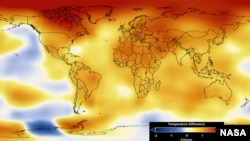The year 2012 was the ninth hottest on record, according to a new global temperature report from NASA, the United States space agency.
A twin analysis from the National Oceanic and Atmospheric Administration (NOAA) ranked 2012 as the 10th warmest year.
The agencies' findings show that, with the exception of 1988, the nine warmest years in the 132-year global weather record have all occurred since the year 2000, with 2010 and 2005 ranked as the hottest years ever.
While the globe experienced relatively warm temperatures last year, NOAA recently reported that the continental United States endured its warmest year ever in 2012.
Average global temperatures fluctuate from year to year. But the new reports, published jointly on Tuesday, provide the latest evidence that rising concentrations of carbon dioxide in the atmosphere resulting from factory, automobile and building emissions, is causing a long-term rise in global temperatures.
"The planet is out of balance," says James Hansen, director of NASA’s Goddard Institute for Space Studies. "There is more energy coming in than going out. And, therefore, we can predict with confidence that the next decade is going to be warmer than the last one."
The NASA and NOAA reports put the average global temperature in 2012 about 14.6 degrees Celsius, which is six-tenths of a degree warmer than the mid-20th century baseline.
The global temperature has risen by eight-tenths of a degree Celsius since 1880, according to the new analysis.
The two reports are based on data from more than 1,000 land-based meteorological stations and from satellite measurements of sea-surface temperatures.
Thomas Karl, director of NOAA’s National Climate Data Center, says the two agencies approached the data differently, but came up with essentially the same picture.
"If you want to compare the differences and anomalies between the NASA and the NOAA data sets, they are quite close, within a few hundredths of a degree Celsius each season," Karl says.
The twin global analyses show that 2010 and 2011 were the wettest years on record.
Precipitation in 2012, however, varied greatly across the planet, with major drought gripping important agricultural regions in eastern Russia, Ukraine, Kazakhstan and central North America.
At the poles, the Arctic experienced a record-breaking ice-melt season in 2012, while the opposite was happening in Antarctica, where ice-sheet extension into the ocean was above-average last year.
A twin analysis from the National Oceanic and Atmospheric Administration (NOAA) ranked 2012 as the 10th warmest year.
The agencies' findings show that, with the exception of 1988, the nine warmest years in the 132-year global weather record have all occurred since the year 2000, with 2010 and 2005 ranked as the hottest years ever.
While the globe experienced relatively warm temperatures last year, NOAA recently reported that the continental United States endured its warmest year ever in 2012.
Average global temperatures fluctuate from year to year. But the new reports, published jointly on Tuesday, provide the latest evidence that rising concentrations of carbon dioxide in the atmosphere resulting from factory, automobile and building emissions, is causing a long-term rise in global temperatures.
"The planet is out of balance," says James Hansen, director of NASA’s Goddard Institute for Space Studies. "There is more energy coming in than going out. And, therefore, we can predict with confidence that the next decade is going to be warmer than the last one."
The NASA and NOAA reports put the average global temperature in 2012 about 14.6 degrees Celsius, which is six-tenths of a degree warmer than the mid-20th century baseline.
The global temperature has risen by eight-tenths of a degree Celsius since 1880, according to the new analysis.
The two reports are based on data from more than 1,000 land-based meteorological stations and from satellite measurements of sea-surface temperatures.
Thomas Karl, director of NOAA’s National Climate Data Center, says the two agencies approached the data differently, but came up with essentially the same picture.
"If you want to compare the differences and anomalies between the NASA and the NOAA data sets, they are quite close, within a few hundredths of a degree Celsius each season," Karl says.
The twin global analyses show that 2010 and 2011 were the wettest years on record.
Precipitation in 2012, however, varied greatly across the planet, with major drought gripping important agricultural regions in eastern Russia, Ukraine, Kazakhstan and central North America.
At the poles, the Arctic experienced a record-breaking ice-melt season in 2012, while the opposite was happening in Antarctica, where ice-sheet extension into the ocean was above-average last year.










